
Chronic Pain: The 20 Most Painful Conditions
Pain is an uncomfortable feeling that tells you something is wrong. People feel pain from time to time, but chronic pain is different. It’s a type of pain that is ongoing and typically lasts longer than six months.
What is chronic pain?
Pain is a signal from the nervous system to let the individual know that something is wrong in the body. Pain may be dull or sharp. Pain can take many forms, and be localized to a part of the body or appear to come from all over. Pain involves a complex interaction between specialized nerves, the brain, and the spinal cord.
Both acute and chronic pain are known. Acute pain lasts less than 3 to 6 months. Usually, it’s directly related to soft tissue damage like a cut, a wound, or a sprained ankle. Acute pain is characterized by its severe or sharp quality. On the other hand, chronic pain lasts more than 6 months. It’s usually associated with an underlying condition, such as arthritis, and is typically less intense, though flare-ups are very common.
Chronic pain can be debilitating and affects a person’s ability to perform activities of daily living. The following includes some of the most painful conditions.

Image Credit: Monika Wisniewska / Shutterstock
20 most painful conditions
Cluster headaches
A cluster headache is a rare type of headache, known for its extreme intensity and a pattern of occurring in “clusters”. Autonomic symptoms such as agitation and restlessness accompany the headache. The pain is so severe that it can affect a person’s ability to perform daily activities. The pain is often preceded by a migraine-like aura and followed by severe pain located quite often at one side of the head. The pain peaks over the next 5 to 10 minutes and intensifies for the next three hours or so. It goes away but may come back up to eight times a day.
Herpes zoster or shingles
Herpes zoster or shingles is a viral disease that affects the nerves. It leads to sharp, shooting, and burning pain, accompanied by itching, tingling, rash, and fluid-filled blisters. The varicella-zoster virus (VZV), the same virus that causes chicken pox, can continue to live in the nerve cells after an attack of chickenpox. It may be reactivated on occasion, to cause shingles in some people. It is among the most painful conditions known. Age and weakened immunity predispose to activation.
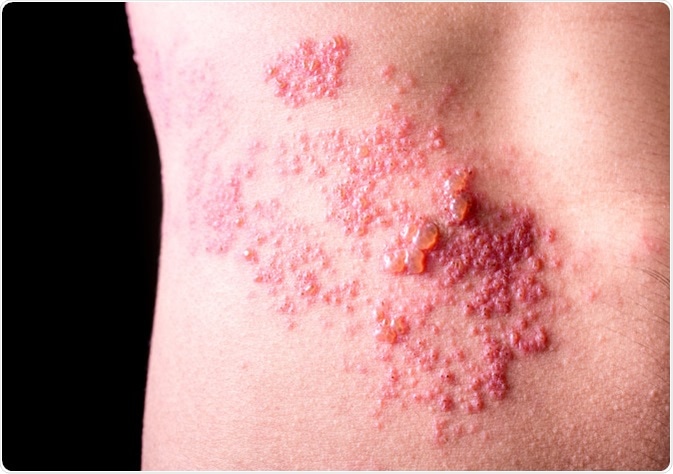
Raised red bumps and blisters caused by shingles on skin - Image Credit: Adtapon Duangnim / Shutterstock
Frozen Shoulder
A frozen shoulder (adhesive capsulitis) is a condition that causes stiffness and pain on the shoulder joint. The signs and symptoms include severe pain, limited range of motion, and stiff shoulder joint. The symptoms begin gradually and worsen over time. It typically resolves within one to three years.
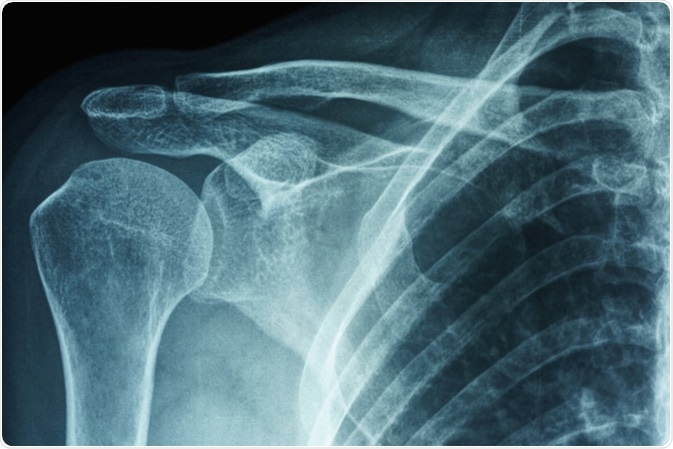
X-ray film of primary frozen shoulder or adhesive capsulitis of Asian female patient. Image Credit: PK289 / Shutterstock
Bone fracture
A fractured bone pertains to a crack or a break in the bone. It can occur in any bone in the body and causes severe pain and inflammation. The severity of a fracture depends on the force that caused the break. Hence, there are many types of fractures – stable, open, transverse, oblique, and comminuted. The pain associated with a fracture is severe and may lead to limitation of movement of the affected area.
Complex regional pain syndrome (CRPS)
Complex regional pain syndrome (CRPS) is a chronic pain condition that affects one limb (foot, hand, leg or arm) after an injury. It usually stems from damage or malfunction of the peripheral and central nervous system. The pain is described as burning, “pins and needles” or squeezing sensation. Aside from the severe pain, other symptoms include changes in skin color, temperature, or swelling of the affected limb.
Heart attack
Heart attack or myocardial infarction (MI) is a potentially fatal condition in which a part of the heart loses its blood supply. It is one of the leading causes of death across the globe. The prevalence of MI approaches three million people worldwide with more than one million deaths in the United States each year. When the blood flow to the heart muscles become blocked, the heart is starved of oxygen and the cells die. The pain of a heart attack is described as crushing chest pain, a feeling of pressure or tightness in the chest, or aching in the chest that spreads to the arms, neck, and jaw.
Slipped disc
Pelvic intervertebral disc prolapse or slipped disc is a condition in which the soft cushion of tissue present between adjacent spinal bones pushes out. A slipped disc can irritate nearby nerves, resulting in pain and numbness or weakness in an arm or leg. The pain worsens after sitting or standing, walking short distances, and with certain movements. The pain is more severe at night, and is accompanied by burning, tingling, and aching sensations on the affected area.
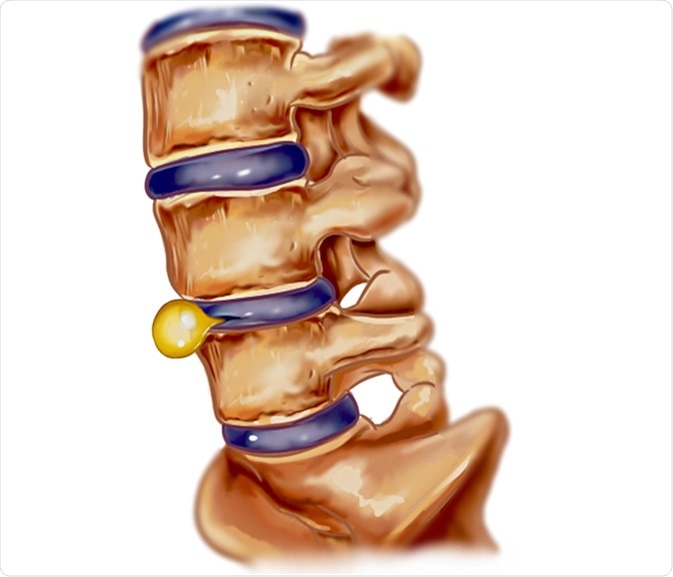
Slipped disc illustration. Image Credit: corbac40 / Shutterstock
Sickle cell disease
Sickle cell disease is a group of blood disorders that affects the structure of hemoglobin, the oxygen-carrying component of the blood. People with this disease have an abnormal form of hemoglobin called hemoglobin S, which alters the shape of red blood cells into a sickle or crescent. A major symptom of sickle cell disease is periodic episodes of pain, called crises. The pain ensues when the sickle-shaped RBCs gather together inside the small blood vessels in the abdomen, joints, and chest, and block the blood flow. In some cases, bone pain can also occur.
Arthritis
Arthritis is a condition characterized by inflammation of one or more of the joints in the body. The main symptoms include pain and stiffness, which affect mobility and worsen with age. The most common types of arthritis include osteoarthritis, rheumatoid arthritis, and gouty arthritis. Arthritis pain, called arthralgia, can feel like a dull ache or a burning sensation.
Migraine headache
Migraine is a recurring type of headache that causes moderate to severe pain of a pulsing or throbbing character. Typically the pain occurs on one side of the head and is accompanied by nausea, vomiting, and extreme sensitivity to sound and light. The pain can last for hours or even days, with pain described as so severe it can be debilitating.
Sciatica
Sciatica refers to the pain that radiates along the path of the sciatic nerve. The sciatic nerve is the longest nerve in the body, running from the hips to the feet. When the nerve is pressed or irritated, it can lead to pain. The pain radiates from the lower lumbar spine to the buttock and down the back of the leg. The pain can be moderate to severe, accompanied by tingling, weakness, and numbness on the affected leg. Severe sciatica can be debilitating, preventing movement.
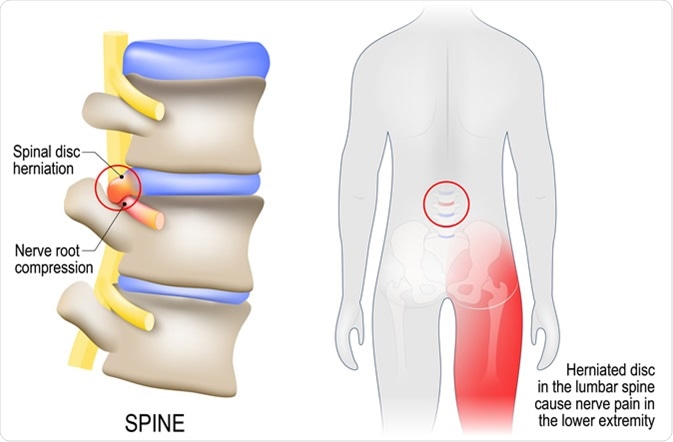
Sciatica diagram with vertebrae, disks and nerves - Image Credit: Designua / Shutterstock
Kidney stones
Kidney stones form when there is a decrease in urine volume or an excess of stone-forming components in the urine. A kidney stone may not cause any symptoms unless it moves around within the kidney and passes down in the ureter. Severe pain may then occur in the side and back, below the ribs, and can radiate to the lower abdomen and groin area.
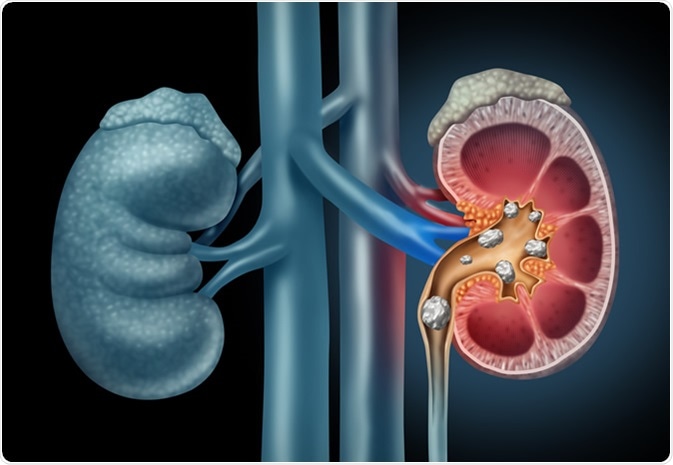
Human Kidney stones medical illustration. Image Credit: Lightspring / Shutterstock
Appendicitis
Appendicitis refers to the inflammation of the appendix, a small and thin pouch connected to the colon. It can become inflamed and lead to severe pain. In severe cases, an inflamed appendix may rupture, leading to peritonitis, a serious infection of the inner lining of the abdomen. The most common symptom of appendicitis is pain that begins near the umbilical area and moves down into the right side of the lower abdomen. It gets worse in a matter of hours, but twinges of sharp pain even before that, when moving around or taking deep breaths.
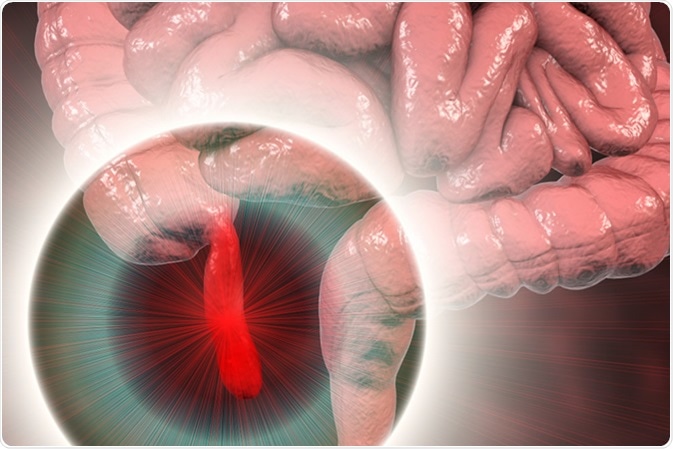
Acute appendicitis, 3D illustration showing inflammed appendix on the cecum. Image Credit: Kateryna Kon / Shutterstock
Trigeminal neuralgia
Trigeminal neuralgia or tic douloureux is a chronic pain condition that affects the trigeminal or fifth cranial nerve. It is one of the most painful conditions known. It causes extreme, sporadic and sudden burning pain or electric shock sensation in the face, including the eyes, lips, scalp, nose, upper jaw, forehead, and lower jaw.
Endometriosis
Endometriosis is a painful condition wherein the tissue that normally lines the endometrium grows outside the uterus. It can grow in the fallopian tubes, ovaries, and the tissue lining the pelvis. The pain occurs before, during, or after menstruation. Some women may feel disabling severe pain. It can also happen during or after sexual intercourse, urination, or bowel movements.
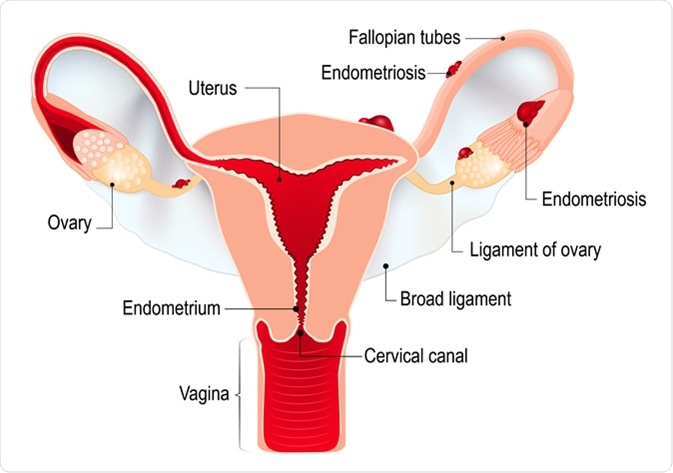
Endometriosis. Schematic drawing of various types of endometriosis disease. Image Credit: Designua / Shutterstock
Gout
Gout is a form of arthritis that develops in some people with high levels of uric acid in the blood. It causes intense pain, stiffness, and swelling in a joint, usually the joint in the big toe. The pain is described as if the foot is on fire.
Acute pancreatitis
Acute pancreatitis is the sudden inflammation of the pancreas, which can be mild or potentially fatal. The main causes of acute pancreatitis are gallstones and alcohol abuse. The predominant symptom is severe abdominal pain. The symptoms may include upper abdominal pain that radiates to the back and becomes worse after eating, accompanied by fever, nausea, vomiting, rapid pulse, and tenderness of the abdomen.
Stomach or peptic ulcer
Peptic ulcers are open sores that form in the lining inside the stomach. Stomach pain is the most common symptom. It may occur anywhere from the belly button to the breastbone. The pain may last briefly or can last for hours, which typically occurs when the stomach is empty or right after eating.
Fibromyalgia
Fibromyalgia is a condition that causes pain all over the body (widespread musculoskeletal pain). It may be accompanied by fatigue, sleep problems, and emotional or mental distress. Patients with the condition may be more sensitive to pain than others. Studies have linked fibromyalgia to how the body amplifies painful sensations due to the brain’s ability to process pain signals. Usually, fibromyalgia occurs after physical trauma, infection, psychological stress or surgery.
Post-surgical pain
Pain occurs after surgery due to impaired skin integrity. But, the severity and characteristic of pain depend on the type of surgery performed.
Sources
- National Center for Advancing Translational Sciences. (2015).Cluster headache. https://rarediseases.info.nih.gov/diseases/10286/cluster-headache
- National Institute on Aging. (2018).Shingles. https://www.nia.nih.gov/health/shingles
- American Academy of Orthopedic Surgeons. (2012). Fractures (Broken Bones).orthoinfo.aaos.org/en/diseases--conditions/fractures-broken-bones/
- National Institute of Neurological Disorders and Stroke. (2019).Complex Regional Pain Syndrome Fact Sheet. www.ninds.nih.gov/.../Complex-Regional-Pain-Syndrome-Fact-Sheet
- National Heart, Lung, and Blood Institute. (2017). Heart Attack. https://www.nhlbi.nih.gov/health-topics/heart-attack
- Genetic Home Reference. (2019). Sickle cell disease. https://ghr.nlm.nih.gov/condition/sickle-cell-disease
- Arthritis Foundation (2019). What Is Arthritis?www.arthritis.org/.../what-is-arthritis.php
- NHS.uk. (2017). Sciatica. https://www.nhs.uk/conditions/sciatica/
- National of Neurological Disorders and Stroke. (2019). Trigeminal Neuralgia Fact Sheet. www.ninds.nih.gov/.../Trigeminal-Neuralgia-Fact-Sheet
- NHS Inform (2019). Acute pancreatitis. www.nhsinform.scot/.../acute-pancreatitis
Further Reading
Last Updated: Jun 14, 2019






















.png)










No hay comentarios:
Publicar un comentario